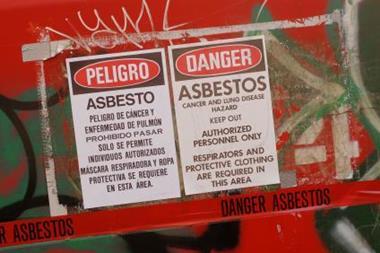As it is ruled that very low-level exposure cases can result in a claim, insurers fear same principles could apply to lung cancer
Insurers received a jolt earlier this month after the Supreme Court ruled that a minimal exposure to asbestos could give rise to a claim.
On 9 March 2011, the Supreme Court handed down its judgment in respect of two appeals in fatal mesothelioma actions. The cases are Sienkiewicz v Greif (UK) Ltd and Willmore v Knowsley MBC.
Following the decisions of the House of Lords in the cases of Fairchild v Glenhaven Funeral Services [2002] and Barker v Corus [2006], liability in a multiple exposure mesothelioma case can be proved if a claimant can establish that a particular exposure gave rise to an increase in risk of injury.
But Sienkiewicz and Willmore were very low-level exposure cases.
'Very light' exposure
In Sienkiewicz, the exposure took place in a factory in Ellesmere Port, Wirral where, Enid Costello, now deceased, was employed as an office worker. She was exposed in certain parts of the factory where limited asbestos was present in the environment.
On the basis of the findings he made, the trial judge described the exposure as "very light". He accepted that, in comparable terms, the factory exposure was only around one-sixth of the exposure that Ms Costello would have received from the general urban environment.
In the Willmore case, the alleged exposure took place in the 1970s when Diane Willmore, also deceased, was a pupil at Bowring Comprehensive School in Huyton, Liverpool.
The exposure came from asbestos ceiling tiles which, on a very occasional basis, had been moved during the course of maintenance work. Again, the alleged exposure was extremely light.
Supreme Court findings
In Sienkiewicz, the defendants won the first instance trial but that decision was overturned by the Court of Appeal in November 2009. In Willmore, the Claimant’s case succeeded at trial, and the decision was upheld by the Court of Appeal. Both defendants appealed to the Supreme Court, and those appeals were heard together at the end of October 2010.
The appeals were dismissed by the seven Supreme Court judges on a unanimous basis. It was decided that:
• Since Fairchild, there has been no real advance in the medical understanding of the cause of mesothelioma. In those circumstances, there is no justification for departing from the Fairchild causation test and in mesothelioma cases the claimant needs to prove that the defendant’s breach of duty materially increased the risk of developing the disease.
• There is no reason to have a different causation test in single exposure cases. In such claims, it is still impossible (because of the state of medical knowledge) to prove whether the mesothelioma was caused by the defendant’s breach of duty or by exposure to asbestos fibres in the general atmosphere.
• The question of whether a particular exposure has materially increased the risk of mesothelioma is for the judge to determine in each case on the basis of the facts. It is not necessary or appropriate to apply the test of ‘doubling the risk’ on the basis of epidemiological evidence.
• In the Sienkiewicz case, the exposure was sufficient to have materially increased the risk of injury (in circumstances where it is known that only a very low level of asbestos exposure is sufficient to cause mesothelioma).
Insurers' woes
“Following this decision of the Supreme Court, it now has to be accepted that in any mesothelioma claim, all the claimant has to prove to succeed on liability is some very low-level asbestos exposure that occurred in circumstances that amounted to breach of duty,” says Hill Dickinson partner David Dunne.
Based on the Court of Appeal decision in Sienkiewicz, defendants and their insurers now face the possibility that any exposure to asbestos, no matter how slight, will give rise to liability.
In addition, following the Compensation Act 2006, the defendant will be responsible for 100% of the claim if no other party is pursued further, adding to insurers’ woes.
“While the judgment may cause trial judges to adapt a more balanced approach in future, the eventual outcome of Willmore proves that even the most generous interpretation of exposure evidence by a judge in favour of a claimant is unlikely to be disturbed by the appeal courts,” Dunne adds.
Exceptional causation?
He points out those insurers are now at a distinctly disadvantaged position when it comes to defending asbestos claims.
“What the decision of the Supreme Court in these appeals has confirmed is that mesothelioma cases are treated as exceptional by the courts in terms of causation, and defendants and their insurers have to try to combat them on a playing field that is decidedly uneven,” he says.
Berrymans Lace Mawer partner Brian Goodwin believes the ruling will create many problems for public liability insurers.
“There is going to be a temptation for victims of mesothelioma, who quite understandably are looking for someone to blame, to look at very light exposure in their past with some optimism that pretty much any exposure may be regarded as material by the trial judge following these two decisions.”
Lung cancer fears
This ruling has also struck another alarming note for insurers. The judge suggested that the same principles could be applied to lung cancer cases.
“If a legal precedent was set, this would dramatically increased asbestos-related claims. This will no doubt be latched upon by claimant’s solicitors,” says Dunne.
Legal experts warn that insurers need to be on their guard following this ruling.
Law firm Keoghs partner David Pugh adds: “What was most interesting about the case was how the Supreme Court chose to expound their view on causation in asbestos case and in particular lung cancer. We have always known that asbestos plays a role in lung cancer,” he says.
“If lung cancer could be brought on the material contribution test, then we could be seeing as many lung cancer cases as mesothelioma, which would be a very significant increase indeed.”




































